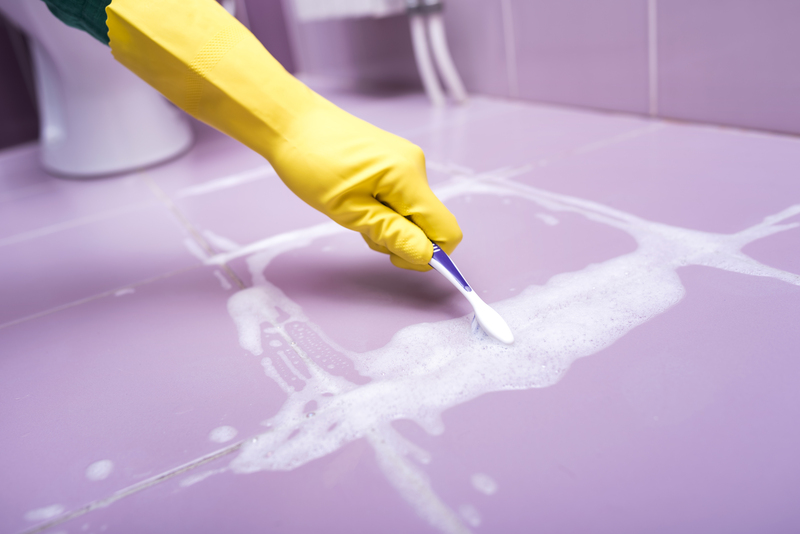Creating a Friendly Atmosphere with Dust-Free, Allergen Control
Posted on 03/06/2025
Creating a Friendly Atmosphere with Dust-Free, Allergen Control
In today's fast-paced world, our homes and workspaces act as sanctuaries where we seek peace, comfort, and relaxation. One of the most overlooked yet vital aspects of maintaining a welcoming environment is ensuring it is dust-free with effective allergen control. By adopting proper dust and allergen management strategies, you can vastly improve air quality, safeguard health, and cultivate a genuinely friendly atmosphere that everyone can enjoy.
Understanding Dust and Indoor Allergens
To conquer indoor air pollutants, it's important first to understand what dust and allergens are. Dust is a complex mixture of tiny particles originating from different sources--dead skin cells, fibers from textiles, pet dander, dirt, pollen, and sometimes even microplastics. Allergens are substances, often part of dust, that provoke allergic reactions in sensitive individuals. Common indoor allergens include dust mite feces, mold spores, and pet proteins.
The Role of Dust in Poor Indoor Air Quality
Dust doesn't just gather in the corners--it circulates and settles on different surfaces, affecting the cleanliness and comfort of your environment. Excess dust contributes to poor indoor air quality, which can lead to:
- Allergic reactions (sneezing, coughing, watery eyes)
- Aggravation of asthma and other respiratory problems
- Reduced immunity and general discomfort
- Accumulation of pathogens and bacteria

The Impact of Allergens on Health and Well-being
Allergens present in dust can cause a spectrum of health issues, especially in children, seniors, and individuals with compromised immune systems. Some of the most prevalent symptoms include:
- Respiratory problems: shortness of breath, wheezing, blocked nose
- Skin irritations: eczema, rashes
- Eye and throat irritation
- Sleep disturbances due to congestion or coughing
Prolonged exposure to dust and indoor allergens may worsen chronic conditions, emphasizing the need for robust dust-free and allergen control strategies.
Benefits of Maintaining a Dust-Free, Allergen-Controlled Atmosphere
Creating a dust-free, allergen-controlled space extends beyond just cleanliness. The benefits include:
- Improved air quality: Cleaner air supports lung health and overall well-being.
- Enhanced comfort: Fewer allergens mean less sneezing, irritation, and discomfort.
- Longer life for furniture and electronics: Dust particles can damage surfaces and internal components of electronics.
- Better sleep: Allergy-free environments help facilitate deeper, more restful sleep.
- Welcoming atmosphere: Guests and residents alike appreciate fresh, allergen-free environments.
Effective Strategies for Dust-Free Environments
Adopting a comprehensive approach to dust and allergen control involves both prevention and removal.
1. Regular Cleaning Routines
Consistency is key. Develop a cleaning schedule that targets dust hotspots. Pay particular attention to:
- Floors: Vacuum and mop at least once a week. Use vacuums with HEPA filters for superior dust removal capabilities.
- Surfaces: Dust furniture, shelves, baseboards, and electronics regularly using microfiber cloths which trap dust particles more efficiently compared to traditional dusters.
- Soft Furnishings: Wash curtains, cushion covers, and bedding every 1-2 weeks. Fabrics are notorious for trapping dust and allergens.
2. Invest in Quality Air Filtration
Improving air filtration is one of the most effective dust-free, allergen control solutions. Some choices include:
- HEPA Air Purifiers: These can remove 99.97% of airborne particles as small as 0.3 microns. Place them in bedrooms and high-traffic areas for best results.
- HVAC Filters: Regularly replace your system's air filters with high-quality versions designed to capture dust and allergens. Make sure to schedule professional maintenance once or twice a year.
3. Manage Humidity Levels
Dust mites and mold thrive in moisture. Maintaining indoor humidity between 30-50% discourages their growth, thus supporting allergen control. Use a humidifier or dehumidifier as needed and regularly ventilate your home, especially bathrooms and kitchens.
4. Reduce Clutter and Soft Furnishings
Less equals more when it comes to dust-free, allergen-minimized spaces. Avoid over-decorating surfaces and choose easy-to-clean decor. Opt for minimal upholstered furniture, and if possible, select leather or vinyl materials that don't trap dust.
5. Transition to Hard Floors
Carpets and rugs are infamous for clinging onto dust and allergens deep within their fibers. If allergy control is a priority, replace carpeting with hardwood, laminate, or tile floors. Area rugs, if used, should be cleaned or beaten outdoors regularly.
6. Pet Hygiene and Management
Pets are beloved family members, but their fur, dander, and saliva contribute significantly to household allergens. To control this:
- Bathe and brush pets regularly, preferably outdoors if the weather allows.
- Keep pets off beds and upholstered furniture.
- Regularly wash pet bedding and toys.
- Create pet-free zones for allergen-sensitive individuals, especially bedrooms.
7. Control Entry Points for Outdoor Allergens
Dust and pollen can hitch a ride indoors on shoes, clothing, and even open windows. A few useful habits include:
- Implementing a shoeless home policy to keep outside dust at bay.
- Installing door mats and vacuuming entryways often.
- Keeping windows shut during high-pollen seasons or when neighbors mow lawns.
Advanced Allergen Management Techniques for Sensitive Individuals
Some circumstances demand a stricter regimen for dust-free, allergen control--for example, homes with infants, elderly, or allergy-prone residents. Techniques include:
- Allergen-proof bedding: Use mattress covers and pillowcases that block dust mites.
- HEPA Vacuum Cleaners: Ensure your vacuum doesn't just redistribute allergens by investing in a HEPA-certified model.
- Electrostatic Filters: Add these to your vents to trap microscopic allergens more effectively.
- Professional air duct cleaning: Periodically eliminate dust, mold, and pollen from your ductwork.
- Limit indoor plants: While beautiful, some plants may harbor mold in their soil.
- Remove wall-to-wall carpeting: Hard surfaces are easier to clean and are less likely to harbor allergens.
Tech Innovations for Dust-Free, Allergen Control
Modern technology offers new ways to elevate your dust-free, allergen-controlled lifestyle:
- Robotic Vacuums: Set schedules for daily cleaning, ensuring a consistently dust-free environment.
- Smart Air Quality Monitors: Track real-time air quality and receive alerts when pollutants spike.
- UV Air Sanitizers: Use ultraviolet light to kill airborne bacteria, viruses, and molds.
These advancements, when combined with traditional cleaning, provide a robust defense against household dust and allergens.
The Psychological Benefits of a Clean, Friendly Atmosphere
A dust-free, allergen-controlled space isn't just beneficial physically--it also supports mental well-being. Studies show that clutter and poor air quality can contribute to stress, anxiety, and reduced productivity. Meanwhile, an environment free of dust and allergens enhances relaxation, improves mood, and encourages social interaction. Your space becomes more inviting for both your family and your guests.
Common Myths About Dust and Allergen Control
Despite the overwhelming evidence, several myths continue to circulate regarding allergen control:
- "Daily cleaning is unnecessary." In reality, small daily habits can greatly reduce allergen accumulation.
- "Allergens are only a problem during allergy season." Many indoor allergens persist year-round, especially dust mites and pet dander.
- "Candles and air fresheners improve air quality." Often, these products release additional chemicals that worsen indoor air quality.
- "You can get rid of all dust." While total elimination is impossible, consistent routines can dramatically minimize dust and its impact.
Integrating Sustainable Practices in Allergen Control
Environmentally-conscious choices can go hand-in-hand with dust and allergen control:
- Opt for eco-friendly cleaning products free from harsh chemicals and fragrances.
- Use washable, reusable microfiber cloths and mops instead of disposable wipes.
- Donate or recycle clutter items rather than throwing away, reducing landfill waste.
- Select durable, sustainable flooring and furnishings that are easier to keep clean.
This green approach not only supports a healthy home but also protects the broader environment.
Balancing Comfort, Style, and Allergen Reduction
Achieving a friendly, dust-free environment does not mean sacrificing personal style or comfort. Consider the following:
- Decorate with washable throws and slipcovers that can be frequently laundered.
- Incorporate storage solutions to reduce visible clutter without removing favorite items.
- Choose light, breathable fabrics for curtains and bedding.
- Display art and photos in frames that can easily be dusted.
In this way, you can combine allergen reduction strategies with aesthetics, creating a space that's both beautiful and health-conscious.

Creating a Lasting Routine for Dust-Free, Allergen-Controlled Living
Consistency is critical. The key to enjoying a long-term, dust-free, allergen-controlled atmosphere lies in making cleaning and maintenance an ingrained part of daily life:
- Delegate: Share cleaning responsibilities among household members for collective upkeep.
- Automate: Set reminders or invest in automated devices to maintain regular cleaning schedules.
- Evaluate: Routinely assess your strategies and make adjustments when new allergens or sources of dust arise.
Conclusion: Make Every Day a Breath of Fresh Air
Creating a friendly atmosphere with dust-free, allergen control is not an overnight job, but the rewards are well worth the effort. By combining knowledge, diligent habits, and modern solutions, your home or workplace will transform into a haven of comfort, health, and peace. Not only will you notice an improvement in your wellbeing, but your family and guests will appreciate the inviting, refreshing embrace of a truly clean, allergen-managed environment. Start today to breathe easier tomorrow--your space, your sanctuary.




